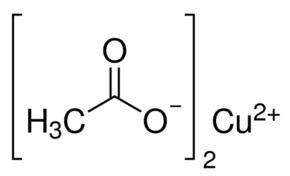 | ||
Appearance Dark green crystalline solid | ||
Synthesis of copper ii acetate
Copper(II) acetate, also referred to as cupric acetate, is the chemical compound with the formula Cu(OAc)2 where AcO− is acetate (CH
3CO−
2). The hydrated derivative, which contains one molecule of water for each Cu atom, is available commercially. Anhydrous Cu(OAc)2 is a dark green crystalline solid, whereas Cu2(OAc)4(H2O)2 is more bluish-green. Since ancient times, copper acetates of some form have been used as fungicides and green pigments. Today, copper acetates are used as reagents for the synthesis of various inorganic and organic compounds. Copper acetate, like all copper compounds, emits a blue-green glow in a flame.
Contents
- Synthesis of copper ii acetate
- Structure
- Synthesis
- Related compounds
- Uses in chemical synthesis
- References
Structure
Copper acetate hydrate adopts the paddle wheel structure seen also for related Rh(II) and Cr(II) tetraacetates. One oxygen atom on each acetate is bound to one copper at 1.97 Å (197 pm). Completing the coordination sphere are two water ligands, with Cu–O distances of 2.20 Å (220 pm). The two five-coordinate copper atoms are separated by only 2.62 Å (262 pm), which is close to the Cu–Cu separation in metallic copper. The two copper centers interact resulting in a diminishing of the magnetic moment such that near 90 K, Cu2(OAc)4(H2O)2 is essentially diamagnetic due to cancellation of the two opposing spins. Cu2(OAc)4(H2O)2 was a critical step in the development of modern theories for antiferromagnetic coupling.
Synthesis
Copper(II) acetate is prepared industrially by heating copper(II) hydroxide or copper(II) carbonate with acetic acid.
Related compounds
Heating a mixture of anhydrous copper(II) acetate and copper metal affords copper(I) acetate:
2 Cu + Cu2(OAc)4 → 4 CuOAcUnlike the copper(II) derivative, copper(I) acetate is colourless and diamagnetic.
"Basic copper acetate" is prepared by neutralizing an aqueous solution of copper(II) acetate. The basic acetate is poorly soluble. This material is a component of verdigris, the blue-green substance that forms on copper during long exposures to atmosphere.
Uses in chemical synthesis
Copper(II) acetate has found some use as an oxidizing agent in organic syntheses. In the Eglinton reaction Cu2(OAc)4 is used to couple terminal alkynes to give a 1,3-diyne:
Cu2(OAc)4 + 2 RC≡CH → 2 CuOAc + RC≡C−C≡CR + 2 HOAcThe reaction proceeds via the intermediacy of copper(I) acetylides, which are then oxidized by the copper(II) acetate, releasing the acetylide radical. A related reaction involving copper acetylides is the synthesis of ynamines, terminal alkynes with amine groups using Cu2(OAc)4. It has been used for hydroamination of acrylonitrile.
It combines with arsenic trioxide to form copper acetoarsenite, a powerful insecticide and fungicide called Paris Green or Schweinfurt Green.
